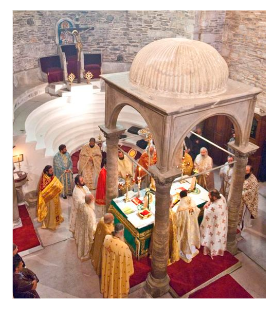Tap or mouse-over on people, animals, objects, symbols, etc. in the icon to learn what they mean. More icons coming soon!


The icon of the Presentation of the Lord, a feastday celebrated on February 2/February 15, depicts the story of when the Holy Theotokos and Joseph observed the Jewish custom of bringing the first-born male child to the Temple to be presented and dedicated to God forty days after his birth. If the parents were wealthy, they had to bring a lamb and a young pigeon or a turtle dove to be offered as a sacrifice at the Temple. But if they were poor, they could offer two pigeons or two turtle doves for the sacrifice. Also depicted are Anna the Prophetess and Symeon the God-receiver. Upholing the same tradition, Orthodox women who have given birth are excused from attending the worship services for 40 days to allow for rest and healing. After the 40 days, the mother and father and newborn child come to the church. The priest prays for the mother and child, offering thanksgiving for their good health and blessing the mother to once again partake of the Holy Sacraments. The child is then "churched" by being carried in the arms of the priest into the church, to be presented to God. In some traditions, a male child is taken into the altar as a blessing and prayer that he might serve God one day in the ministry of the priesthood.






